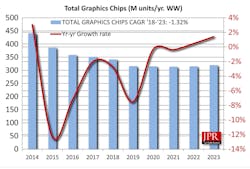Where Are GPUs Headed in 2021?
>> Electronic Design Resources
.. >> Digital Editions
.. .. >> Top Stories of the Week
.. .. .. >> 2021 Electronic Design Forecasts
Before the early 1980s, graphics controllers were made with dozens of discrete logic chips. NEC revolutionized the graphics market with the first VLSI graphics controller chip. Moore’s Law took over and improved graphics controllers, which were renamed GUI accelerators in the 1990s when Windows became bitmapped. Matrix math and transformations were moved from the CPU to a new class of programmable devices known as the GPU in 1999. However, the first programmable graphics processor was built in 1986 by Texas Instruments.
In the early 1990s, over 70 companies were making, designing, or promising a 3D controller. Many of them contributed to the advancement of the industry; almost all of them vanished. In particular, Intel has tried five times to launch a standalone graphics processor and is now reentering the market once again. GPUs moved into smartphones in 2006 and revolutionized mobile devices. Game consoles used early GPUs back in 1996, and CPUs got GPUs embedded in them in 1991.
The range and depth of graphics processors is enormous and stretches to supercomputers and AI—the grammar editor in Word runs on Nvidia GPUs in Microsoft’s Azure cloud system. GPUs tell pilots where and how to fly, they get us to and from friends and shops, and they do lightning-fast stock market transactions. They make special effects in movies not only possible but fantastic. And, they make video games so realistic you think you’re in a movie.
The first half of 2020’s shipments of total graphics processors (integrated/embedded and discrete) increased by 2.5% from the previous quarter, which is an improvement over the 10-year average historical rate of −1.5%. A total of 89.9 million units were shipped in the second quarter of 2020, which increased by 9.05 million units from the same quarter a year ago, indicating the GPU market is pretty good on a year-to-year basis.
The Forecast
Our forecast for the PC graphics market reveals a 0.25% CAGR from 2018 to 2023 (see figure).
The graphics chip market, which includes PCs and other systems that use the PC architecture (e.g., POS systems and industrial, scientific, and medical systems) as well as PCs with “one-size-fits-all” motherboards (AKA mainboard, system board, or planar board) that have integrated graphics and a graphics add-in board (AIB), have shown remarkable robustness over the years despite recessions, internet booms and busts, and threats from handheld devices.
Most upstream suppliers and downstream brand vendors shared the view that their third-quarter shipments will pick up further, reversing their earlier pessimism that sales could drop in the quarter. In addition to normal seasonal inventory replenishment for the consumer market segment, which is showing stronger-than-expected momentum, shipments for Japan's GIGA (Global and Innovation Gateway for All) School Project will peak in the third quarter with at least 3.5 million units.
We’re about to enter a new phase in graphics processors. This is probably the last generation of mega GPUs. Nvidia’s recently introduced A100—a single chip—has an unimaginable 54 billion transistors, measures 826 mm2, and consumes 300 W.
The next generation of GPUs will be made with chiplets. That will enable scaling and help bring down power consumption. They will have networks of internal communications and become stacked 3D devices with memory on-chip.
About the Author

Jon Peddie
President
Dr. Jon Peddie heads up Tiburon, Calif.-based Jon Peddie Research. Peddie lectures at numerous conferences on topics pertaining to graphics technology and the emerging trends in digital media technology. He is the former president of Siggraph Pioneers, and is also the author of several books. Peddie was recently honored by the CAD Society with a lifetime achievement award. Peddie is a senior and lifetime member of IEEE (joined in 1963), and a former chair of the IEEE Super Computer Committee. Contact him at [email protected].

